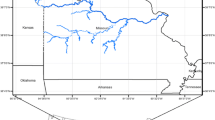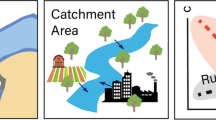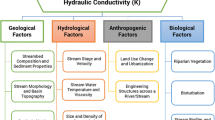Abstract
Agricultural and urban runoff pumped into the perimeter canals of the Arthur R. Marshall Loxahatchee National Wildlife Refuge (Refuge), a 58,320-ha soft-water wetland, has elevated nutrients which impact the Refuge interior marsh. To best manage the Refuge, linkages between inflows to the perimeter canals and environmental conditions within the marsh need to be understood. Conductivity, which typically is high in the canals and lowest at the most interior sites, was used as a surrogate tracer to characterize patterns of constituent transport. The Refuge was initially classified into four zones based upon patterns and variability in conductivity data: Canal Zone; Perimeter Zone (canal to 2.5 km into the interior); Transition Zone (2.5 to 4.5 km from the canal); Interior Zone (>4.5 km from the canal). Conductivity variability declined from the Perimeter to the Interior Zone, with the highest variability in the marsh observed in the Perimeter Zone and the lowest variability observed in the Interior Zone. Analysis of other water quality parameters indicated that conditions in the Perimeter and Transition Zones were different, and more impacted, than in the Interior Zone. In general, there was a positive relationship between structure inflows and canal phosphorus concentrations, including discharges from treatment wetlands and bypasses of untreated water. This classification approach is applicable for stratified sampling designs, resolving spatial bias in water quality models, and in aiding in management decisions about resource allocation.
Similar content being viewed by others
References
Abtew, W., Huebner, R. S., & V. Ciuca, V. (2006). In G. Redfield, S. Efron, & K. Burns (Eds.) Chapter 5: Hydrology of the South Florida Environment. 2006 South Florida Environmental Report. West Palm Beach, FL: South Florida Water Management District.
Arceneaux, J., Meselhe, E. A., & Waldon, M. G. (2007). The Arthur R. Marshall Loxahatchee National Wildlife Refuge Water Budget and Water Quality Models. LOXA 07-004. Lafayette, Louisiana: University of Louisiana at Lafayette & the U.S. Fish and Wildlife Service In preparation.
Boyer, J. N., Fourqurean, J. W., & Jones, R. D. (1997). Spatial characterization of water quality in Florida Bay and Whitewater Bay by multivariate analyses: zones of similar influence. Estuaries, 20, 743–758.
Brandt, L. A., Harwell, M. C., & Waldon, M. G. (2004). Work Plan: Water Quality Monitoring and Modeling for the A.R.M. Loxahatchee National Wildlife Refuge. Boynton Beach, FL: Arthur R. Marshall Loxahatchee National Wildlife Refuge, U.S. Fish and Wildlife Service.
Childers, D. L., Doren, R. F., Jones, R., Noe, G. B., Rugge, M., & Scinto, L. J. (2003). Decadal change in vegetation and soil phosphorus pattern across the Everglades landscape. Journal of Environmental Quality, 32, 344–362.
Davis, S. M. (1994). In S. M. Davis, & J. C. Ogden (Eds.) Phosphorus inputs and vegetation sensitivity in the Everglades. Everglades: The Ecosystem and Its Restoration. Delray Beach, FL: St. Lucie Press.
Davis, S. M., Gunderson, L. H., Park, W. A., Richardson, J. R., & Mattson, J. E. (1994). In S. M. Davis, & J. C. Ogden (Eds.) Landscape dimension, composition, and function in a changing Everglades ecosystem. Everglades: The Ecosystem and Its Restoration. Delray Beach, FL: St. Lucie Press.
Gaiser, E. E., Childers, D. L., Jones, R. D., Richards, J. H., Scinto, L. J., & Trexler, J. C. (2006). Periphyton responses to eutrophication in the Florida Everglades: Cross-system patterns of structural and compositional change. Limnology and Oceanography, 51, 617–630.
Gleason, P. J., Stone, P., Hallett, D., & Rosen, M. (1975). Preliminary report on the effects of agricultural runoff on the periphytic algae of Conservation Area 1 (South Florida Water Management District). West Palm Beach, FL.
Güler, C., Thyne, G. D., McCray, J. E., & Turner, K. A. (2002). Evaluation of graphical and multivariate statistical methods for classification of water chemistry data. Hydrogeology Journal, 10, 455–474.
Harvey, J. W., Krupa, S. L., & Krest, J. M. (2004). Ground Water Recharge and Discharge in the Central Everglades. Ground Water, 42, 1090–1102.
Harwell, M., Surratt, D., Waldon, M., Walker, B., & Brandt, L. (2005). A.R.M. Loxahatchee National Wildlife Refuge Enhanced Water Quality Monitoring and Modeling Interim Report. Boynton Beach, FL.
Helsel, D. R. (2005). Nondetects and data analysis: statistics for censored environmental data. New York: John Wiley and Sons, Inc.
Hutcheson, M. R. (1998). Implementation of acute criteria for conservative substances. Journal of the American Water Resources Association, 34, 1025–1033.
Jassby, A. D., Cole, B. E., & Cloern, J. E. (1997). The design of sampling transects for characterizing water quality in estuaries. Estuarine, Coastal and Shelf Science, 45, 285–302.
Kadlec, R. H., & Knight, R. L. (1996). Treatment Wetlands. Boca Raton, FL: Lewis Publishers.
Kratzer, C. R., & Biagtan, R. N. (1997). Determination of traveltimes in the lower San Joaquin River Basin, California, from dye-tracer studies during 1994–1995. Water Resources Investigations Report 97–4018. U.S. Geological Survey.
Lin, S., & Gregg, R. (1988). Water Budget Analysis: Water Conservation Area 1. DRE 245. West Palm Beach, FL: South Florida Water Management District.
Lopez, R. D., & Fennessy, M. S. (2002). Testing the floristic quality assessment index as an indicator of wetland condition along gradients of human influence. Ecological Applications, 12, 487–497.
Mayer, T. D. (2005). Water-quality impacts of wetland management in the Lower Klamath National Wildlife Refuge, Oregon and California, USA. Wetlands, 25, 697–712.
Mayer, T. D., & Thomasson, R. (2004). Fall water requirements for seasonal dikes wetlands at Lower Klamath National Wildlife Refuge. Wetlands, 24, 92–103.
McCormick, P., & Crawford, E. S. (2006). Vegetation responses to mineral gradients in an ombrotrophic northern Everglades peatland, the Arthur R. Marshall Loxahatchee National Wildlife Refuge. Paper presented at the 2006 Greater Everglades Ecosystem Restoration Conference, Orlando, FL.
McCormick, P. V., Newman, S., Payne, G., Miao, S., & Fontaine, T. D. (2000). In G. Redfield (Ed.) Chapter 3: Ecological effects of phosphorus enrichment in the Everglades. 2000 Everglades Consolidated Report. West Palm Beach, FL: South Florida Water Management District.
Mitsch, W. J., Band, L. E., & Cerco, C. F. (2007). Everglades Landscape Model (ELM), Version 2.5: Peer Review Panel Report. Submitted January 3, 2007 to the South Florida Water Management District, West Palm Beach, FL.
O'Dell, K. M., VanArman, J., Welch, B. H., & Hill, S. D. (1995). Changes in water chemistry in a macrophyte-dominated lake before and after herbicide treatment. Lake and Reservoir Management, 11, 311–316.
Payne, G., Bennett, T., & Weaver, K. (2002). In G. Redfield (Ed.) Chapter 5: Development of a Numeric Phosphorus Criterion for the Everglades Protection Area. 2002 Everglades Consolidated Report. West Palm Beach, FL: South Florida Water Management District.
Payne, G., & Weaver, K. (2004). In G. Redfield (Ed.) Chapter 2C: Status of phosphorus and nitrogen in the Everglades Protection Area. 2004 Everglades Consolidated Report. West Palm Beach, FL: South Florida Water Management District.
Redfield, G. W. (2002). Atmospheric deposition of phosphorus to the Everglades: Concepts, constraints, and published deposition rates for ecosystem management. TheScientificWorldJOURNAL, 2, 1843–1873.
Ryberg, K. R. (2006). Cluster analysis of water-quality data for Lake Sakakawea, Audubon Lake, and McClusky Canal, central North Dakota, 1990–2003. U.S. Geological Survey Scientific Investigations Report 2006–5202.
SFWMD (2006). Monitoring plan for Everglades Protection Area—Water Conservation Area 1 (WCA1) Project: EVPA. Version: 10 July, 2006.
Sigua, G. C., & Tweedale, W. A. (2004). Assessing redesigned effectiveness of the water quality monitoring program in the Indian River Lagoon, Florida. Aquatic Conservation: Marine and Freshwater Ecosystems, 14, 49–64.
Sklar, F. H., Rutchey, K., Hagerthy, S., Cook, M., Newman, S., Miao, S., et al. (2005). In G. Redfield, S. Efron, & K. Burns (Eds.) Chapter 6: Ecology of the Everglades Protection Area. 2005 South Florida Environmental Report. West Palm Beach, FL: South Florida Water Management District.
Smith, E. P., & McCormick, P. V. (2001). Long-term relationships between phosphorus inputs and wetland phosphorus concentrations in a northern Everglades marsh. Environmental Monitoring and Assessment, 68, 153–176.
Strobl, R. O., Robillard, P. D., Shannon, R. D., Day, R. L., & McDonnell, A. J. (2006). A water quality monitoring network design methodology for the selection of critical sampling points: Part I. Environmental Monitoring and Assessment, 112, 137–158.
Surratt, D., Waldon, M. G., Harwell, M. C., & Aumen, N. (2007). Time-series and spatial tracking of polluted canal water intrusion into wetlands of a National Wildlife Refuge in Florida, USA. Wetlands (in press).
Sutula, M., Day, J. W., Cable, J., & Rudnick, D. (2001). Hydrological and nutrient budgets of freshwater and estuarine wetlands of Taylor Slough in Southern Everglades, Florida (U.S.A.). Biogeochemistry, 56, 287–310.
United States v. SFWMD, et al. (1988). Case No. 88-1886-CIV-MORENO—Settlement Agreement. United States District Court Southern District of Florida, Miami Division, Miami, FL.
USFWS (2000). Arthur R. Marshall Loxahatchee National Wildlife Refuge Comprehensive Conservation Plan. Boynton Beach, FL: U.S. Fish and Wildlife Service.
USFWS (2007). A.R.M. Loxahatchee National Wildlife Refuge—Enhanced Monitoring and Modeling Program—2nd Annual Report—February 2007. LOXA06-008. Boynton Beach, FL: U.S. Fish and Wildlife Service.
Waldon, M. (2005). TOC Working Group to Examine Refuge TP Concentrations in May and June 2005. Technical Oversight Committee meeting on October 18, 2005.
Walker Jr., W. W. (1999). In K. R. Reddy, G. A. O’Connor, & C. L. Schelske (Eds.) Long-term water quality trends in the EvergladesPhosphorus biogeochemistry in sub-tropical ecosystems: Florida as a case example. Boca Raton, FL: CRC/Lewis Publishers.
Walker, W. W., & Jewell, S. D. (1997). Atmospheric deposition of phosphorus in Loxahatchee National Wildlife Refuge. Paper presented at: Atmospheric deposition into South Florida: Measuring net atmospheric inputs of nutrients, South Florida Water Management District, West Palm Beach, FL.
Weaver, K. C., & Payne, G. G. (2006). In G. Redfield, S. Efron, & K. Burns (Eds.), Chapter 2A-Status of water quality in the Everglades Protection Area. 2006 South Florida Environmental Report. West Palm Beach, FL: South Florida Water Management District.
Author information
Authors and Affiliations
Corresponding author
Rights and permissions
About this article
Cite this article
Harwell, M.C., Surratt, D.D., Barone, D.M. et al. Conductivity as a tracer of agricultural and urban runoff to delineate water quality impacts in the northern Everglades. Environ Monit Assess 147, 445–462 (2008). https://doi.org/10.1007/s10661-007-0131-3
Received:
Accepted:
Published:
Issue Date:
DOI: https://doi.org/10.1007/s10661-007-0131-3




